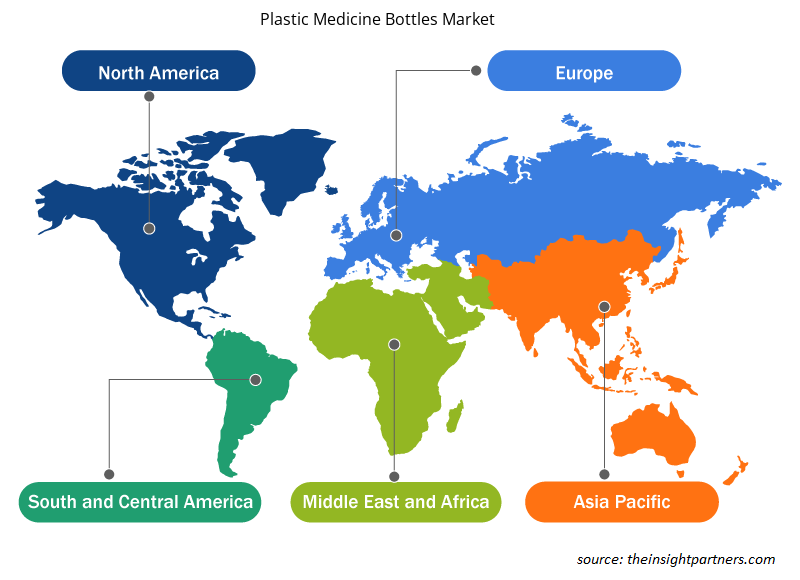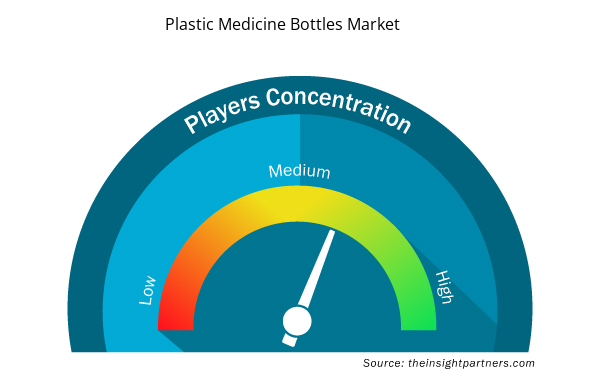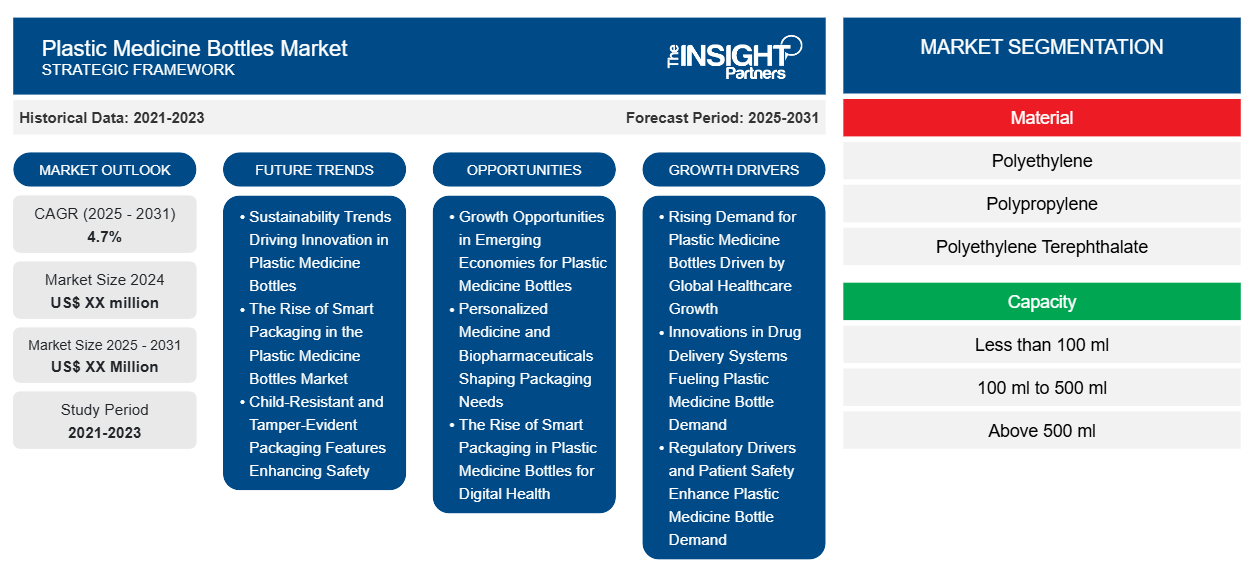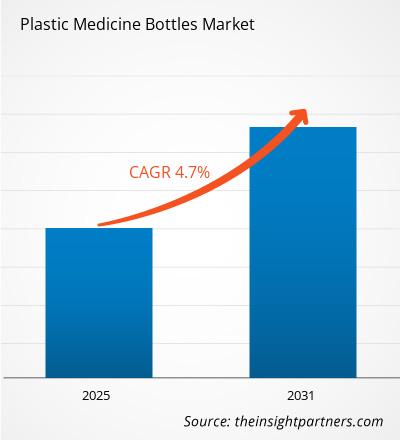Se espera que el mercado de botellas de plástico para medicamentos registre una CAGR del 4,7 % entre 2023 y 2031, con un tamaño de mercado que se expandirá de US$ XX millones en 2023 a US$ XX millones en 2031.
El informe está segmentado por material (polietileno, polipropileno, tereftalato de polietileno, cloruro de polivinilo y otros). El informe está segmentado además por capacidad (menos de 100 ml, de 100 ml a 500 ml y más de 500 ml). El informe está segmentado por tipo de producto (frasco gotero, frasco atomizador nasal, frasco para el cuidado bucal, recipientes para sólidos y otros). El alcance del informe cubre cinco regiones: América del Norte, Europa, Asia Pacífico, Medio Oriente y África, y América del Sur y Central y los países clave de cada región. El análisis global se desglosa aún más a nivel regional y por países principales. El informe ofrece el valor en USD para el análisis y los segmentos anteriores.
Propósito del Informe
El informe Plastic Medicine Bottles Market de The Insight Partners tiene como objetivo describir el panorama actual y el crecimiento futuro, los principales factores impulsores, los desafíos y las oportunidades. Esto proporcionará información a diversas partes interesadas del negocio, como:
- Proveedores/fabricantes de tecnología: Para comprender la dinámica cambiante del mercado y conocer las oportunidades potenciales de crecimiento, lo que les permitirá tomar decisiones estratégicas informadas.
- Inversionistas: Realizar un análisis exhaustivo de tendencias sobre la tasa de crecimiento del mercado, las proyecciones financieras del mercado y las oportunidades que existen en toda la cadena de valor.
- Órganos reguladores: Regular las políticas y vigilar las actividades del mercado con el objetivo de minimizar los abusos, preservar la confianza de los inversores y defender la integridad y la estabilidad del mercado.
Segmentación del mercado de botellas de plástico para medicamentos
Material
- Polietileno
- Polipropileno
- Tereftalato de polietileno
- Cloruro de polivinilo
Capacidad
- Menos de 100 ml
- 100 ml a 500 ml
- Más de 500 ml
Tipo de producto
- Frasco gotero
- Botella de spray nasal
- Botella para el cuidado bucal
- Contenedores sólidos
Geografía
- América del norte
- Europa
- Asia-Pacífico
- América del Sur y Central
- Oriente Medio y África
Geografía
- América del norte
- Europa
- Asia-Pacífico
- América del Sur y Central
- Oriente Medio y África
Personalice este informe según sus necesidades
Obtendrá personalización en cualquier informe, sin cargo, incluidas partes de este informe o análisis a nivel de país, paquete de datos de Excel, así como también grandes ofertas y descuentos para empresas emergentes y universidades.
- Obtenga las principales tendencias clave del mercado de este informe.Esta muestra GRATUITA incluirá análisis de datos, desde tendencias del mercado hasta estimaciones y pronósticos.
Factores impulsores del crecimiento del mercado de botellas de plástico para medicamentos
- La creciente demanda de frascos de plástico para medicamentos impulsada por el crecimiento mundial de la atención sanitaria: la creciente demanda mundial de productos farmacéuticos, medicamentos de venta libre y suplementos para la salud exige la producción en masa de frascos de plástico para medicamentos en todo el mundo. Las recetas médicas, así como los medicamentos de venta libre, son los principales impulsores de la demanda de frascos de plástico para medicamentos durante la fase actual de demanda creciente provocada por el aumento de la población mundial, el envejecimiento demográfico y las enfermedades crónicas. Los líquidos farmacéuticos, los comprimidos y las cápsulas se envasan ampliamente en frascos de plástico para medicamentos por su durabilidad, rentabilidad y facilidad de uso. Debido al crecimiento de la industria de la atención sanitaria, una mayor demanda de envases de medicamentos eficaces y seguros sigue siendo una tendencia principal en el mercado de los frascos de plástico para medicamentos.
- Las innovaciones en los sistemas de administración de medicamentos impulsan la demanda de frascos de plástico para medicamentos: las innovaciones en los sistemas de administración de medicamentos, como los productos farmacéuticos líquidos y de dosis oral, también han aumentado la demanda de frascos de plástico para medicamentos. Además de la expansión de los sistemas de formulación y administración de medicamentos, las compañías farmacéuticas también se están centrando en los frascos de plástico como medio de envasado para ciertos tipos específicos de medicamentos en el área de especialización. Los frascos de plástico para medicamentos han ganado más aceptación para envasar no solo medicamentos orales sino también otros productos farmacéuticos líquidos que exigen un alto nivel de barrera contra la humedad y el oxígeno para evitar la degradación de los medicamentos durante el envasado, el almacenamiento y la administración.
- Los factores regulatorios y la seguridad del paciente aumentan la demanda de botellas de plástico para medicamentos: algunos de los principales impulsores del mercado de botellas de plástico para medicamentos incluyen altos niveles de presión regulatoria sobre las compañías farmacéuticas para garantizar la seguridad, integridad y trazabilidad de los productos. Los gobiernos y las agencias regulatorias de todo el mundo, desde la FDA y la Administración de Alimentos y Medicamentos de los EE. UU. hasta la Agencia Europea de Medicamentos, requieren envases a prueba de manipulaciones y cierres a prueba de niños para los productos farmacéuticos. Estas características siempre se han incluido en las botellas de plástico para medicamentos. Serían útiles para cumplir con las regulaciones, la seguridad del paciente y también contra la falsificación. Esta tendencia regulatoria impulsa aún más la demanda de envases de plástico seguros en el sector farmacéutico.
Tendencias futuras del mercado de botellas de plástico para medicamentos
- Tendencias de sostenibilidad que impulsan la innovación en los frascos de plástico para medicamentos: El escenario de la sostenibilidad ha surgido recientemente como la última tendencia en el mercado de los frascos de plástico para medicamentos. La conciencia ambiental entre los consumidores sobre los efectos perjudiciales de los plásticos está cambiando el enfoque de las compañías farmacéuticas hacia un mejor sustituto en términos de soluciones de envasado sostenibles. Más que nunca, los fabricantes están produciendo frascos de plástico reciclables para medicamentos a partir de PET. Además, el uso de plásticos biodegradables, acompañado por el crecimiento generalizado de materiales ecológicos para tapas y etiquetas de botellas, también está desarrollándose significativamente. Este cambio hacia la sostenibilidad va en línea con las preferencias de los consumidores al tiempo que ayuda a las compañías farmacéuticas a cumplir con los estándares regionales e internacionales sobre la gestión de residuos plásticos.
- El auge de los envases inteligentes en el mercado de los frascos de plástico para medicamentos: las empresas farmacéuticas demandan la innovación de envases a prueba de niños y con precinto de seguridad en el mercado, y esto dio lugar a la creación de un determinado tipo de frascos de plástico para medicamentos que incorporaban propiedades de envase a prueba de niños y con precinto de seguridad. Se está dando cada vez más importancia a la seguridad del paciente y a la prevención de la ingestión accidental de medicamentos por parte de los niños, por lo que los cierres a prueba de niños y los precintos con precinto de seguridad están cobrando cada vez más importancia. Estas características se están introduciendo cada vez más en el envasado de medicamentos de venta libre, vitaminas y fármacos con receta en frascos de plástico, lo que está impulsando nuevas dimensiones de innovación y diferenciación en los diseños de envases. El mercado de este tipo de soluciones también se ampliará con unas normas de seguridad más estrictas.
- Características de los envases a prueba de niños y a prueba de manipulaciones que mejoran la seguridad: una tendencia emergente en el mercado de los envases de plástico para medicamentos, basada en una demanda cada vez mayor de soluciones en materia de salud digital y adherencia a la medicación, se ha identificado como envases inteligentes. En este sentido, se prevé el desarrollo de botellas de plástico inteligentes con sensores integrados, códigos QR o etiquetas RFID para ayudar a rastrear el uso, hacer un seguimiento de la gestión del inventario y proporcionar alertas recordatorias al paciente. Estas soluciones de envases "conectados" ayudan a los proveedores de atención médica y a los pacientes a garantizar que cualquier medicación a la que se espera adherencia se siga de manera efectiva y que, como tal, se mejoren los resultados generales del tratamiento. El mayor uso de la telemedicina y las tecnologías de control de la salud también impulsan la utilización de envases inteligentes; las empresas farmacéuticas ahora están ansiosas por incorporar herramientas digitales a su oferta.
Oportunidades de mercado para botellas de plástico para medicamentos
- Oportunidades de crecimiento en las economías emergentes para los frascos de plástico para medicamentos: Las economías emergentes de las regiones de Asia-Pacífico, América Latina y África tienen grandes oportunidades de crecimiento en el mercado de frascos de plástico para medicamentos. Existe un gran aumento en la demanda de soluciones de envasado para medicamentos en estas regiones debido a que un mejor acceso a la atención médica y un mayor consumo de productos farmacéuticos han generado esa tendencia. Esa tendencia está siendo impulsada por las poblaciones emergentes de clase media, la creciente conciencia de la salud y las inversiones realizadas por los gobiernos en infraestructura de atención médica. Las empresas pueden penetrar en estos mercados en crecimiento a través de la localización, las asociaciones con firmas farmacéuticas regionales y envases de bajo costo que atraigan a los consumidores sensibles al precio.
- La medicina personalizada y los productos biofarmacéuticos están dando forma a las necesidades de envasado: la medicina personalizada y los productos biofarmacéuticos siguen siendo tendencias que cambian el estado de los frascos de plástico para medicamentos. En general, los productos biofarmacéuticos, como los productos biológicos, las vacunas y las terapias genéticas, requieren un envasado específico que proporcione la estabilidad y la protección adecuadas al producto. Por lo tanto, estos envases serían adecuados para los frascos de plástico, que tienen propiedades de barrera mejoradas. De manera similar, la medicina personalizada podría consistir en dosis más pequeñas, o incluso individualizadas, que se pueden llenar fácilmente en frascos de plástico para medicamentos más pequeños. Por lo tanto, los fabricantes estarían interesados en analizar oportunidades de asociación con empresas biofarmacéuticas para desarrollar soluciones de envasado personalizadas para los nuevos tipos de medicamentos.
- El auge de los envases inteligentes en los frascos de plástico para medicamentos para la salud digital: la convergencia digital entre las tecnologías sanitarias y los envases farmacéuticos presenta una oportunidad para la adopción de frascos de plástico para medicamentos, especialmente aquellos con soluciones de envasado inteligentes. El sistema puede realizar un mejor seguimiento de los medicamentos, las dosis y la adherencia al hacer que los frascos de plástico estén habilitados con sensores, NFC o tecnología Bluetooth. Esto es muy relevante para el tratamiento de enfermedades crónicas, en las que los pacientes tienen que tomar los medicamentos recetados de forma rutinaria. A medida que aumenta la demanda de soluciones digitales relacionadas con la salud, la introducción de funciones inteligentes en los frascos de plástico para medicamentos será una de las vías de crecimiento más prometedoras para los fabricantes que están interesados en la innovación y en agregar valor a los envases tradicionales.
Perspectivas regionales del mercado de botellas de plástico para medicamentos
Los analistas de Insight Partners explicaron en detalle las tendencias y los factores regionales que influyen en el mercado de botellas de plástico para medicamentos durante el período de pronóstico. Esta sección también analiza los segmentos y la geografía del mercado de botellas de plástico para medicamentos en América del Norte, Europa, Asia Pacífico, Oriente Medio y África, y América del Sur y Central.

- Obtenga datos regionales específicos para el mercado de botellas de plástico para medicamentos
Alcance del informe de mercado de botellas de plástico para medicamentos
| Atributo del informe | Detalles |
|---|---|
| Tamaño del mercado en 2023 | XX millones de dólares estadounidenses |
| Tamaño del mercado en 2031 | US$ XX millones |
| CAGR global (2023 - 2031) | 4,7% |
| Datos históricos | 2021-2022 |
| Período de pronóstico | 2024-2031 |
| Segmentos cubiertos | Por material
|
| Regiones y países cubiertos | América del norte
|
| Líderes del mercado y perfiles de empresas clave |
|
Densidad de actores del mercado de botellas de plástico para medicamentos: comprensión de su impacto en la dinámica empresarial
El mercado de los frascos de plástico para medicamentos está creciendo rápidamente, impulsado por la creciente demanda de los usuarios finales debido a factores como la evolución de las preferencias de los consumidores, los avances tecnológicos y una mayor conciencia de los beneficios del producto. A medida que aumenta la demanda, las empresas amplían sus ofertas, innovan para satisfacer las necesidades de los consumidores y aprovechan las tendencias emergentes, lo que impulsa aún más el crecimiento del mercado.
La densidad de actores del mercado se refiere a la distribución de las empresas o firmas que operan dentro de un mercado o industria en particular. Indica cuántos competidores (actores del mercado) están presentes en un espacio de mercado determinado en relación con su tamaño o valor total de mercado.
Las principales empresas que operan en el mercado de botellas de plástico para medicamentos son:
- Amcor plc
- Compañía global de bayas Inc.
- Gerresheimer AG
- Compañía O.Berk
- Grupo Aptar, Inc.
Descargo de responsabilidad : Las empresas enumeradas anteriormente no están clasificadas en ningún orden particular.

- Obtenga una descripción general de los principales actores clave del mercado de botellas de plástico para medicamentos
Puntos de venta clave
- Cobertura integral: el informe cubre de manera integral el análisis de productos, servicios, tipos y usuarios finales del mercado de botellas de plástico para medicamentos, proporcionando un panorama holístico.
- Análisis de expertos: el informe se compila sobre la base de un profundo conocimiento de expertos y analistas de la industria.
- Información actualizada: El informe asegura relevancia comercial debido a su cobertura de información reciente y tendencias de datos.
- Opciones de personalización: este informe se puede personalizar para satisfacer los requisitos específicos del cliente y adaptarse adecuadamente a las estrategias comerciales.
Por lo tanto, el informe de investigación sobre el mercado de botellas de plástico para medicamentos puede ayudar a abrir camino para descifrar y comprender el escenario de la industria y las perspectivas de crecimiento. Si bien puede haber algunas preocupaciones válidas, los beneficios generales de este informe tienden a superar las desventajas.
- Análisis histórico (2 años), año base, pronóstico (7 años) con CAGR
- Análisis PEST y FODA
- Tamaño del mercado Valor/volumen: global, regional, nacional
- Industria y panorama competitivo
- Conjunto de datos de Excel



Report Coverage
Revenue forecast, Company Analysis, Industry landscape, Growth factors, and Trends

Segment Covered
This text is related
to segments covered.

Regional Scope
North America, Europe, Asia Pacific, Middle East & Africa, South & Central America

Country Scope
This text is related
to country scope.
Preguntas frecuentes
Increased use of child-resistant and tamper-evident features is expected to be the key market trend.
The report can be delivered in PDF/Word format, we can also share excel data sheet based on request.
On the basis of geography, the plastic medicine bottles market is classified into North America, Europe, Asia Pacific, Middle East and Africa, and South and Central America
Amcor Plc, Berry Global Inc, Gerresheimer AG, AptarGroup Inc, O.Berk Co LLC, Mykron Plus India Pvt Ltd, Pro-Pac Packaging Ltd, Comar LLC, AptarGroup Inc, and Graham Packaging Co
The major factors driving the plastic medicine bottles market are:
1. Growing Demand for Pharmaceuticals and Healthcare Products.
2. Regulations on Safe and Tamper-Evident Packaging.
The Plastic Medicine Bottles Market is estimated to witness a CAGR of 4.7% from 2023 to 2031
Trends and growth analysis reports related to Chemicals and Materials : READ MORE..
1. Amcor plc
2. Berry Global Inc.
3. Gerresheimer AG
4. O.Berk Company
5. AptarGroup, Inc.
6. ALPHA PACKAGING
7. Graham Packaging Company
8. Alpack, Inc.
9. PLASTIPAK HOLDINGS, INC.
10. Drug Plastics Group
The Insight Partners performs research in 4 major stages: Data Collection & Secondary Research, Primary Research, Data Analysis and Data Triangulation & Final Review.
- Data Collection and Secondary Research:
As a market research and consulting firm operating from a decade, we have published and advised several client across the globe. First step for any study will start with an assessment of currently available data and insights from existing reports. Further, historical and current market information is collected from Investor Presentations, Annual Reports, SEC Filings, etc., and other information related to company’s performance and market positioning are gathered from Paid Databases (Factiva, Hoovers, and Reuters) and various other publications available in public domain.
Several associations trade associates, technical forums, institutes, societies and organization are accessed to gain technical as well as market related insights through their publications such as research papers, blogs and press releases related to the studies are referred to get cues about the market. Further, white papers, journals, magazines, and other news articles published in last 3 years are scrutinized and analyzed to understand the current market trends.
- Primary Research:
The primarily interview analysis comprise of data obtained from industry participants interview and answers to survey questions gathered by in-house primary team.
For primary research, interviews are conducted with industry experts/CEOs/Marketing Managers/VPs/Subject Matter Experts from both demand and supply side to get a 360-degree view of the market. The primary team conducts several interviews based on the complexity of the markets to understand the various market trends and dynamics which makes research more credible and precise.
A typical research interview fulfils the following functions:
- Provides first-hand information on the market size, market trends, growth trends, competitive landscape, and outlook
- Validates and strengthens in-house secondary research findings
- Develops the analysis team’s expertise and market understanding
Primary research involves email interactions and telephone interviews for each market, category, segment, and sub-segment across geographies. The participants who typically take part in such a process include, but are not limited to:
- Industry participants: VPs, business development managers, market intelligence managers and national sales managers
- Outside experts: Valuation experts, research analysts and key opinion leaders specializing in the electronics and semiconductor industry.
Below is the breakup of our primary respondents by company, designation, and region:

Once we receive the confirmation from primary research sources or primary respondents, we finalize the base year market estimation and forecast the data as per the macroeconomic and microeconomic factors assessed during data collection.
- Data Analysis:
Once data is validated through both secondary as well as primary respondents, we finalize the market estimations by hypothesis formulation and factor analysis at regional and country level.
- Macro-Economic Factor Analysis:
We analyse macroeconomic indicators such the gross domestic product (GDP), increase in the demand for goods and services across industries, technological advancement, regional economic growth, governmental policies, the influence of COVID-19, PEST analysis, and other aspects. This analysis aids in setting benchmarks for various nations/regions and approximating market splits. Additionally, the general trend of the aforementioned components aid in determining the market's development possibilities.
- Country Level Data:
Various factors that are especially aligned to the country are taken into account to determine the market size for a certain area and country, including the presence of vendors, such as headquarters and offices, the country's GDP, demand patterns, and industry growth. To comprehend the market dynamics for the nation, a number of growth variables, inhibitors, application areas, and current market trends are researched. The aforementioned elements aid in determining the country's overall market's growth potential.
- Company Profile:
The “Table of Contents” is formulated by listing and analyzing more than 25 - 30 companies operating in the market ecosystem across geographies. However, we profile only 10 companies as a standard practice in our syndicate reports. These 10 companies comprise leading, emerging, and regional players. Nonetheless, our analysis is not restricted to the 10 listed companies, we also analyze other companies present in the market to develop a holistic view and understand the prevailing trends. The “Company Profiles” section in the report covers key facts, business description, products & services, financial information, SWOT analysis, and key developments. The financial information presented is extracted from the annual reports and official documents of the publicly listed companies. Upon collecting the information for the sections of respective companies, we verify them via various primary sources and then compile the data in respective company profiles. The company level information helps us in deriving the base number as well as in forecasting the market size.
- Developing Base Number:
Aggregation of sales statistics (2020-2022) and macro-economic factor, and other secondary and primary research insights are utilized to arrive at base number and related market shares for 2022. The data gaps are identified in this step and relevant market data is analyzed, collected from paid primary interviews or databases. On finalizing the base year market size, forecasts are developed on the basis of macro-economic, industry and market growth factors and company level analysis.
- Data Triangulation and Final Review:
The market findings and base year market size calculations are validated from supply as well as demand side. Demand side validations are based on macro-economic factor analysis and benchmarks for respective regions and countries. In case of supply side validations, revenues of major companies are estimated (in case not available) based on industry benchmark, approximate number of employees, product portfolio, and primary interviews revenues are gathered. Further revenue from target product/service segment is assessed to avoid overshooting of market statistics. In case of heavy deviations between supply and demand side values, all thes steps are repeated to achieve synchronization.
We follow an iterative model, wherein we share our research findings with Subject Matter Experts (SME’s) and Key Opinion Leaders (KOLs) until consensus view of the market is not formulated – this model negates any drastic deviation in the opinions of experts. Only validated and universally acceptable research findings are quoted in our reports.
We have important check points that we use to validate our research findings – which we call – data triangulation, where we validate the information, we generate from secondary sources with primary interviews and then we re-validate with our internal data bases and Subject matter experts. This comprehensive model enables us to deliver high quality, reliable data in shortest possible time.


 Obtenga una muestra gratuita de este informe
Obtenga una muestra gratuita de este informe